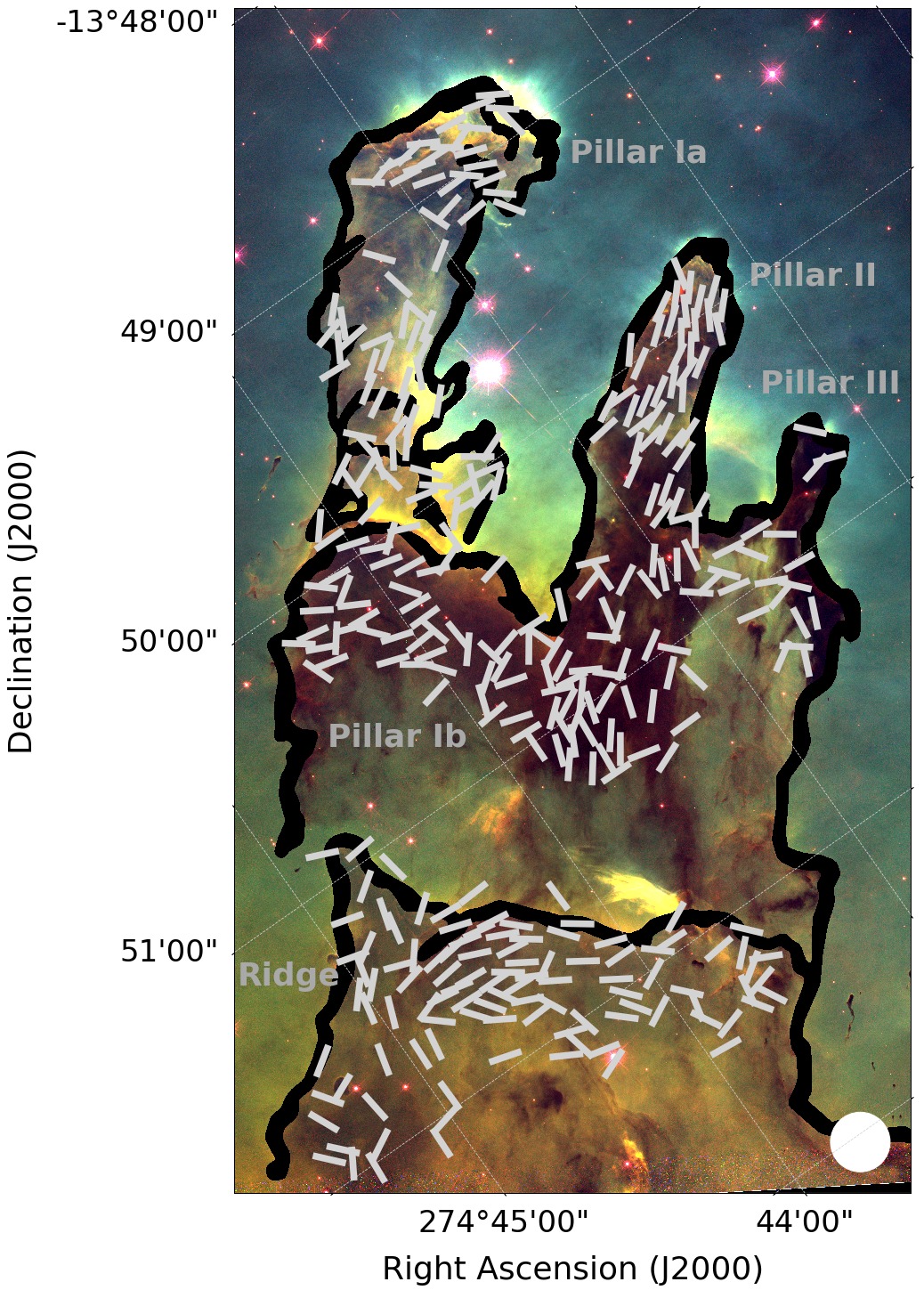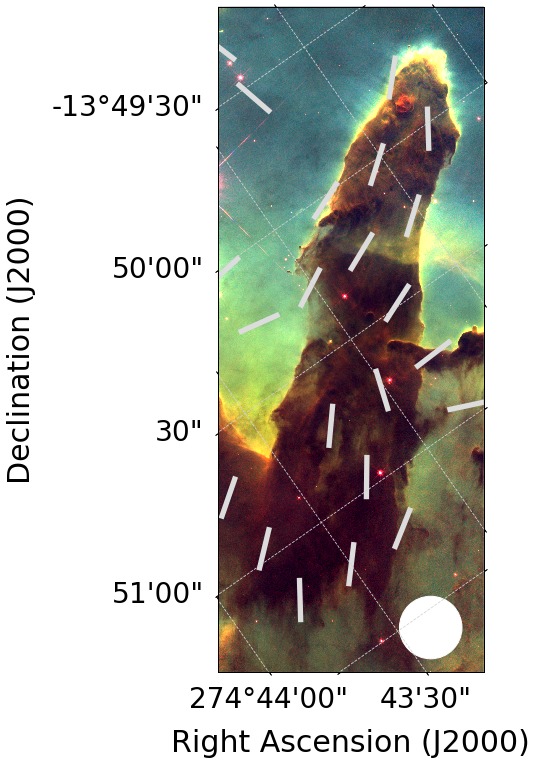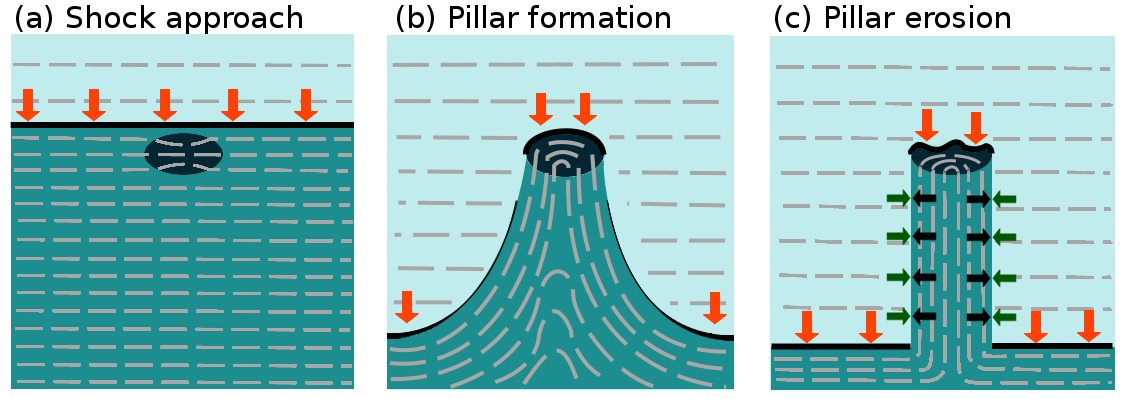The BISTRO (B-Fields in Star-Forming Region Observations) Survey has for the first time mapped the magnetic field in the dense gas of the ‘Pillars of Creation’, using instruments on the James Clerk Maxwell Telescope (JCMT). The Pillars of Creation, in the Messier 16 star-forming region, which is also known as the Eagle Nebula, were the subject of one of the most iconic images taken by the Hubble Space Telescope (HST). The Pillars are a set of columns of cold, dense gas protruding into a region of hot, ionized plasma. The Pillars have nurseries of new stars forming at their tips, and are a particularly dramatic example of a feature found in many regions of interstellar space in which high-mass stars are forming.
We present the first high-resolution observations of the Pillars in polarized light at submillimeter wave- lengths – submillimeter light being on the cusp between infrared and radio waves, where the cold, dense dust and gas which will form the next generation of stars emits most of its light. Light emitted from these dusty regions is polarized perpendicular to the direction of its local magnetic field, and so we can use our observations to directly probe the magnetic field morphology within the dense gas of the Pillars of Creation. Our observations were taken at a wavelength of 0.85 mm as part of the BISTRO Survey, using the POL-2 polarimeter on the SCUBA-2 submillimeter camera at the JCMT. They show that the magnetic field runs along the length of the pillars, at a significantly different angle to the field in the surrounding ionized plasma, and has an estimated strength of approximately 170 − 320 microGauss (1.7 − 3.2 × 10−8 Tesla), an intermediate magnetic field strength for a region of space which is forming stars.

An illustrative figure of the BISTRO magnetic field vectors observed in the Pillars of Creation, overlaid on a HST 502 nm, 657 nm and 673 nm composite – HST imaging from Hester et al. (1996, AJ 111, 2349).
Young hot stars, with masses more than eight times that of the Sun, produce large numbers of high-energy photons. These high-energy photons ionize a volume of the region within which they form, splitting hydrogen atoms into pairs of protons and elections. As the shock front between the material ionized by the young stars and the untouched neutral material advances, complex structures form in the dense gas at the interface. Particularly, pillars of dense, neutral gas like those in M16 are found protruding into the ionized region, apparently left behind by the advancing shock front. The formation and evolution of these pillars is not well-understood – debate continues as to whether these pillars form behind obstructions to the shock front, or whether they can form from turbulent instabilities in the shock front itself. The role of the magnetic field in the formation of the Pillars is particularly uncertain, since the strength of the magnetic field in the dense parts of the Pillars has not been measured until now.

BISTRO magnetic field vectors overlaid on a HST 502 nm, 657 nm and 673 nm composite image of Pillar II. The magnetic field runs roughly parallel to the Pillar’s axis. No polarization is detected at the Pillar’s tip – this depolarization is consistent with a horseshoe-shaped magnetic field morphology on scales smaller than the beam.
Our observations of the magnetic field running along the length of the Pillars are consistent with the Pillars being formed by compression of gas with an initially weak magnetic field: the magnetic field has not had the strength to resist being dragged into its current configuration by the motions of the gas. However, the magnetic field strength appears to have been increased by being compressed in the forming pillars. The magnetic field strength that we estimate is large enough to magnetically support the sides of Pillars against collapsing radially under pressure from the surrounding hot plasma, and to prevent the Pillars collapsing under their own gravity. It is important to note though that the Pillars are still being destroyed by the same shock interaction that created them: the magnetic field that we measure is not strong enough to prevent the Pillars being gradually eroded from their tips by the effects of the young stars in the region. Our results suggest that the evolution and lifetime of the Pillars may thus be strongly influenced by the strength and orientation of their magnetic field: the Pillars’ longevity results from magnetic support.

Our proposed evolutionary scenario: (a) an ionization front moving perpendicular to the am- bient magnetic field approaches an existing over-density in the molecular gas. (b) The ionization front is slowed by the over-density. The flux-frozen magnetic field ‘bows’ into the forming pillar. (c) The com- pressed magnetic field supports the pillar against further gas-pressure- and gravity-driven radial collapse, but cannot support against longitudinal erosion of the over-density by ionizing photons. Throughout, dark blue shading represents molecular gas and light blue shading represents ionized material. The ionization front is shown as a black line. Grey dashed lines indicate the local magnetic field direction. Red arrows represent photon flux, black arrows represent magnetic pressure, and green arrows represent thermal gas pressure.
The James Clerk Maxwell Telescope, located on Mauna Kea in Hawaii, is operated by the East Asian Observatory. The BISTRO Survey is a large team of scientists working to understand the role of mag- netic fields in the formation of stars, with members from across the partner regions of the East Asian Observatory: China, Japan, South Korea, Taiwan and Vietnam, and from participating universities in the United Kingdom and Canada.
This research has been accepted for publication by The Astrophysical Journal Letters. A pre-print is available at http://arxiv.org/abs/1805.11554.
Kate Pattle, Derek Ward-Thompson, Tetsuo Hasegawa, Pierre Bastien, Woojin Kwon, Shih-Ping Lai, Keping Qiu, Ray Furuya, David Berry and the JCMT BISTRO Survey Team
The “Pillars of Creation” is one of the most well-known images in astronomy, and it is very exciting to be able to add to what is known about this part of the sky. The pillars are beautiful structures – remarkable for their highly coherent structure within the dynamic and highly energetic environment of a region forming high-mass stars. We have found that the magnetic field within the Pillars is well-ordered, running along the length of the pillars, and is strong enough to influence the future evolution of the pillars, helping to support them against collapse. This is an intriguing result because it shows us that the magnetic field is important to the region now, but also that it was likely not very important during the period when the pillars were forming. The field appears to have changed significantly from its original direction to run along the pillars as they were formed by a shock interaction caused by nearby young stars. This could not have happened if the magnetic field were strong enough to resist being moved. Our results suggest that the importance of the magnetic field to the Pillars of Creation has evolved over time along with the Pillars themselves.
The JCMT is the only telescope in the world which could have made these observations – the JCMT’s POL-2 polarimeter and SCUBA-2 camera are a unique combination of instruments, observing at the wavelengths at which cold dust in star-forming regions emits most of its light. POL-2 provides information on the magnetic field on the scale of objects such as the Pillars of Creation which is not available anywhere else.
We have already had a proposal accepted by the Submillimeter Array (SMA) on Mauna Kea to observe the magnetic field in the tips of the pillars in more detail. In our JCMT observations we see the magnetic field disappear at the tips of the pillars. This “depolarization” could be caused by tangled magnetic field lines or a complete reversal of magnetic field direction in the pillars’ tips causing the field to cancel out in our observations. By observing at higher resolution with the SMA we will be able to see what the magnetic field looks like on these small scales, and to better understand what role the magnetic field is playing in the shock interaction which is driving the pillars’ evolution. We could also potentially look in more detail still at the magnetic field in clumps in the pillars’ tips using the Atacama Millimeter/submillimeter Array (ALMA) in Chile, or observe the pillars in polarized near-infrared light using the airborne SOFIA observatory.
-2018/06/05



